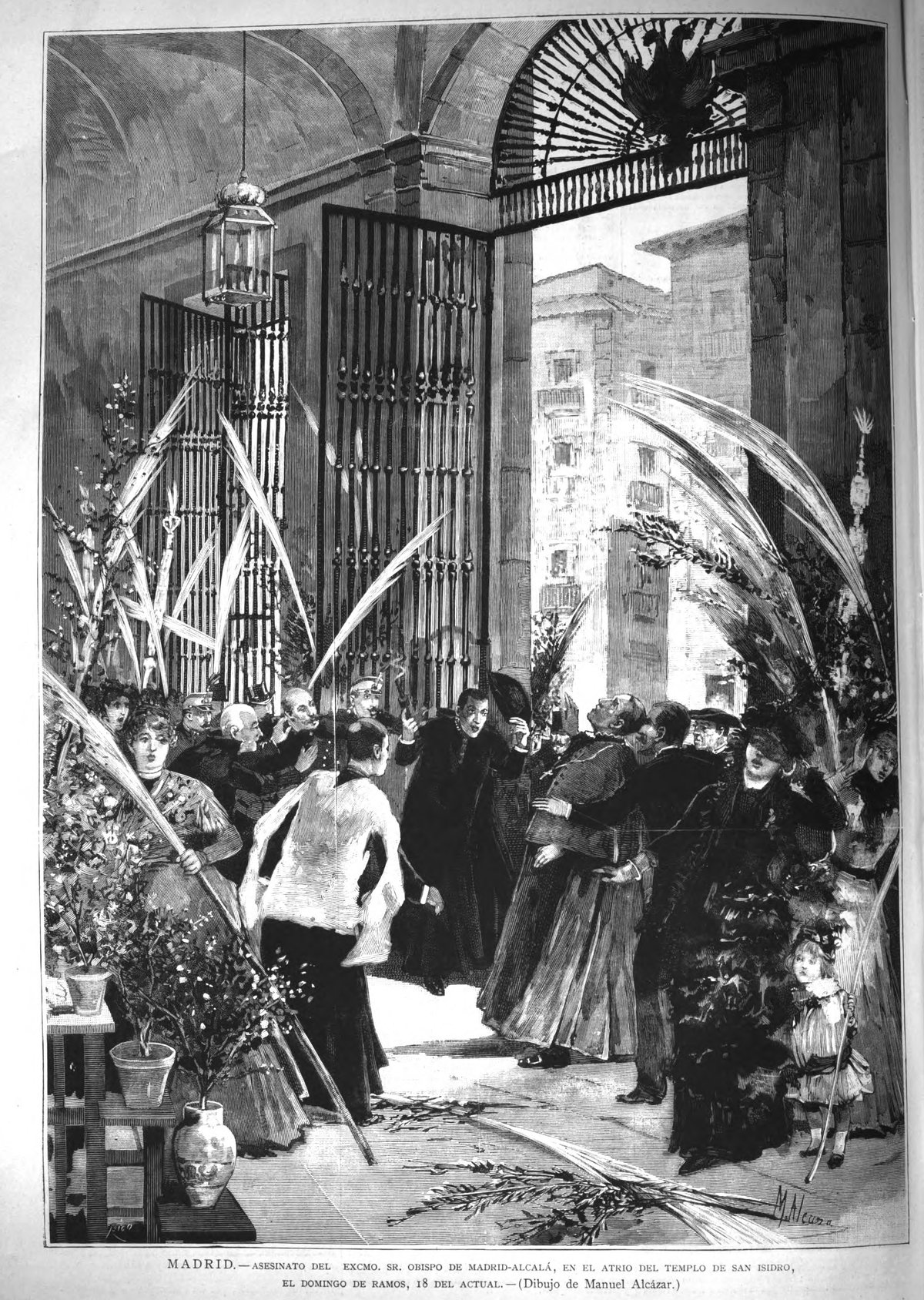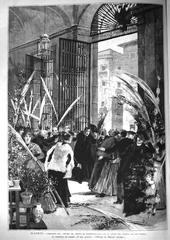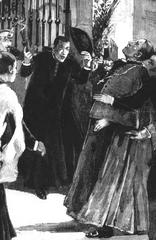
San Isidro Church Madrid: Visiting Hours, Tickets, and Historical Guide
Date: 14/06/2025
Introduction
San Isidro Church—officially the Real Basílica Colegiata de San Isidro—is one of Madrid’s foremost religious and cultural landmarks. Located in the heart of the city’s historic center near Plaza Mayor and the Royal Palace, this Baroque masterpiece is a testament to centuries of faith, artistry, and communal tradition (info-countries.com; Esmadrid). Constructed in the 17th century by Jesuit architects, its granite façade, crowned with Corinthian columns and statues of San Isidro and Santa María de la Cabeza, welcomes visitors to a site deeply woven into Madrid’s urban and spiritual identity.
The church is the final resting place of San Isidro Labrador, Madrid’s patron saint, whose miracles are celebrated every May during the city’s largest festival. Historically, San Isidro Church also served as the city’s provisional cathedral from 1885 until 1993, and its survival and restoration after the Spanish Civil War highlight Madrid’s resilience and commitment to heritage preservation (Sacred Destinations; Wikipedia).
This comprehensive guide covers the church’s history, architectural highlights, visiting hours, ticketing, accessibility, guided tours, and insider tips for the San Isidro Festival and other nearby attractions. Prepare to explore one of Madrid’s most iconic sites, where faith, art, and community converge (official Madrid tourism site; The Making of Madrid).
Historical Overview and Significance
Origins and Construction
The San Isidro Church was constructed in the 17th century in the Baroque style, designed by Jesuit architects and modeled after Il Gesù in Rome (info-countries.com; Sacred Destinations). Its Latin cross floor plan, single nave, side chapels, and central dome typify the period’s architectural ideals. The church’s granite façade is adorned with sculptures of San Isidro and his wife, Santa María de la Cabeza, symbolizing its spiritual significance. Situated on Calle Toledo, the church is a short walk from Plaza Mayor, although the narrow street can make it challenging to fully appreciate the façade’s scale.
Role as Madrid’s Provisional Cathedral
From 1885 until 1993, San Isidro Church functioned as Madrid’s provisional cathedral, playing host to major religious ceremonies until the completion of Almudena Cathedral (info-countries.com). This era further cemented its role as a focal point of Madrid’s religious life.
Relics of San Isidro and Santa María de la Cabeza
The church houses the relics of San Isidro Labrador and his wife, Santa María de la Cabeza, enshrined in the main altarpiece. San Isidro, canonized in 1622, is revered for his miracles, including the legendary well miracle that saved his son. These relics draw pilgrims year-round, particularly during the annual San Isidro Festival (info-countries.com).
Spanish Civil War and Restoration
A devastating fire during the Spanish Civil War in 1936 destroyed the dome and several artworks, prompting a decades-long restoration (Wikipedia). The reconstructed church preserves much of its original Baroque character, with new sections added to the towers in the 1960s.
Architectural and Artistic Heritage
San Isidro Church exemplifies Spanish Baroque architecture. Its façade, with granite construction and Corinthian columns, conveys grandeur and solemnity. The main altarpiece, a highlight of the interior, was faithfully recreated after the war. Despite the loss of significant artworks, the restored church remains a repository of Baroque art, featuring gilded moldings, stucco work, and intricate chapels (Wikipedia).
The church’s setting within Madrid’s medieval Austrias district further enhances its historical significance. Surrounded by winding streets and hidden courtyards, it stands amidst a district where Moorish and Christian influences converge (Veronika’s Adventure).
The Patron Saint: San Isidro Labrador
San Isidro Labrador, born around 1070, is Madrid’s patron saint and a symbol of the city’s religious and agricultural heritage (The Making of Madrid). His miracles, such as angelic ploughing and miraculous springs, are celebrated annually. Canonized in 1622, San Isidro remains a spiritual protector for Madrid’s people, especially farmers and laborers (Sacred Destinations; Travel Buddies).
The San Isidro Festival: Madrid’s Iconic Celebration
Each May, the Fiestas de San Isidro honor the city’s patron saint with a vibrant blend of religious, cultural, and culinary traditions (whatmadrid.com; Cat’s Hostels). The festival centers on the church, with processions, blessings, chulapo costumes, chotis dancing, and traditional foods like rosquillas and cocido. The Pradera de San Isidro park becomes the heart of open-air celebrations, with music, picnics, and fireworks.
Key Festival Highlights
- Religious Ceremonies: Processions and Masses featuring the relics of San Isidro and Santa María de la Cabeza.
- Traditional Dress and Dance: Chulapos and chulapas perform the chotis in public squares.
- Gastronomy: Local specialties include cocido, limonada, and various rosquillas.
- Music & Entertainment: Concerts, parades, and fireworks across the city.
The festival showcases Madrid’s communal spirit and living heritage, making the church a hub of both religious devotion and popular celebration (Esmadrid).
Visitor Information
Visiting Hours & Tickets
- General Hours: Typically open Tuesday–Sunday, 10:00 AM–2:00 PM and 4:00 PM–7:00 PM (hours may vary during services and festivals; always check ahead).
- Admission: Free; donations appreciated. Guided tours or special events may require tickets.
- Guided Tours: Available through local operators and official tourism channels. Recommended for deeper historical and artistic context.
- Accessibility: Ramps and assistance available; some historic areas may have limited access.
Getting There
- Metro: La Latina (Line 5), Tirso de Molina (Line 1)
- Bus: Multiple routes serve the area.
- On Foot: Short walk from Plaza Mayor and other Old Town sites.
Nearby Attractions
Explore the Austrias district, Plaza Mayor, the Royal Palace, Almudena Cathedral, Basilica of San Francisco el Grande, and remnants of Madrid’s Arab Wall. The surrounding neighborhood offers plenty of cafes, shops, and cultural venues (Veronika’s Adventure).
Practical Tips
- Best Time to Visit: Weekday mornings for a quieter experience; festival period (mid-May) for vibrant celebrations.
- Photography: Permitted without flash; respect religious services.
- Accessibility: The church and festival venues are largely accessible, but expect crowds during peak times.
Frequently Asked Questions (FAQ)
Q: What are the San Isidro Church visiting hours?
A: Generally, Tuesday–Sunday, 10:00 AM–2:00 PM and 4:00 PM–7:00 PM. Always check current schedules.
Q: Is there an admission fee?
A: No; entry is free. Donations are welcome.
Q: Are guided tours available?
A: Yes, through official tourism channels and local operators.
Q: Is the church wheelchair accessible?
A: Yes, with ramps and facilities available.
Q: When is the San Isidro Festival?
A: Annually in mid-May, with main events on May 15.
Conclusion
San Isidro Church is a cornerstone of Madrid’s heritage, encapsulating centuries of faith, art, and communal celebration. Whether you visit for its Baroque architecture, spiritual resonance, or the exuberant San Isidro Festival, your experience will connect you to the very heart of Madrid. Combine your visit with nearby attractions, consider a guided tour for deeper insights, and let the living traditions of San Isidro enrich your journey through the Spanish capital.
For updated information, guided tours, and festival schedules, download the Audiala app and follow official Madrid tourism platforms.



































































































